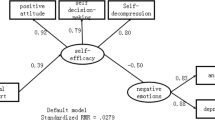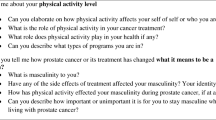Abstract
Background
To manage incontinence following tumor surgery, prostate cancer patients are advised to perform pelvic floor exercise (PFE). Patients’ self-efficacy and support from partners were shown to facilitate PFE. Whereas support may enhance self-efficacy (enabling function), self-efficacy may also cultivate support (cultivation function).
Purpose
Cross-lagged inter-relationships among self-efficacy, support, and PFE were investigated.
Method
Post-surgery patient-reported received support, self-efficacy, PFE, and partner-reported provided support were assessed from 175 couples at four times. Autoregressive models tested interrelations among variables, using either patients’ or partners’ reports of support.
Results
Models using patients’ data revealed positive associations between self-efficacy and changes in received support, which predicted increased PFE. Using partners’ accounts of support provided, these associations were partially cross-validated. Furthermore, partner-provided support was related with increases in patients’ self-efficacy.
Conclusion
Patients’ self-efficacy may cultivate partners’ support provision for patients’ PFE, whereas evidence of an enabling function of support as a predictor of self-efficacy was inconsistent.




Similar content being viewed by others
References
Ferlay J, Soerjomataram I, Dikshit R, et al. Cancer incidence and mortality worldwide: Sources, methods and major patterns in GLOBOCAN 2012. Int J Cancer. 2015; 136: E359-E386.
Bill-Axelson A, Holmberg L, Garmo H, et al. Radical prostatectomy or watchful waiting in early prostate cancer. N Engl J Med. 2014; 370: 932-942.
Resendes LA, McCorkle R. Spousal responses to prostate cancer: An integrative review. Cancer Invest. 2006; 24: 192-198.
Resnick MJ, Koyama T, Fan KH, et al. Long-term functional outcomes after treatment for localized prostate cancer. N Engl J Med. 2013; 368: 436-445.
Dorey G, Glazener C, Buckley B, Cochran C, Moore K. Developing a pelvic floor muscle training regimen for use in a trial intervention. Physiotherapy. 2009; 95: 199-208.
Burkert S, Knoll N, Luszczynska A, Gralla O. The interplay of dyadic and individual planning of pelvic-floor exercise in prostate-cancer patients following radical prostatectomy. J Behav Med. 2012; 35: 305-317.
Burkert S, Knoll N, Scholz U, Roigas J, Gralla O. Self-regulation following prostatectomy: Phase-specific self-efficacy beliefs for pelvic-floor exercise. Br J Health Psychol. 2012; 17: 273-293.
Sacomori C, Cardoso FL, Porto IP, Negri NB. The development and psychometric evaluation of a self-efficacy scale for practicing pelvic floor exercises. Braz J Phys Ther. 2013; 17: 336-342.
Khan CM, Iida M, Stephens MAP, et al. Spousal support following knee surgery: Roles of self-efficacy and perceived emotional responsiveness. Rehabil Psychol. 2009; 54: 28-32.
Benight CC, Bandura A. Social cognitive theory of posttraumatic recovery: The role of perceived self-efficacy. Behav Res Ther. 2004; 42: 1129-1148.
Schwarzer R, Knoll N. Functional roles of social support within the stress and coping process: A theoretical and empirical overview. Int J Psychol. 2007; 42: 243-252.
Berkman LF, Glass T, Brissette I, Seeman TE. From social integration to health: Durkheim in the new millennium. Soc Sci Med. 2000; 51: 843-857.
Dunkel-Schetter C, Blasband DE, Feinstein LG, Herbert TB. Elements of supportive interactions: When are attempts to help effective? In: Spacapan S, Oskamp S, eds. Helping and being helped: Naturalistic studies. Newbury Park: Sage Publications; 1992: 83-114.
Giangrasso B, Casale S. Psychometric properties of the Medical Outcome Study Social Support Survey with a general population sample of undergraduate students. Soc Indic Res. 2014; 116: 185-197.
Holt-Lunstad J, Smith TB, Layton JB. Social relationships and mortality risk: A meta-analytic review. PLoS Med. 2010; 7: 1-20.
DiMatteo MR. Social support and patient adherence to medical treatment: A meta-analysis. Health Psychol. 2004; 23: 207-218.
Ochsner S, Knoll N, Stadler G, et al. Interacting effects of receiving social control and social support during smoking cessation. Ann Behav Med. 2015; 49: 141-146.
Hogan BE, Linden W, Najarian B. Social support interventions: Do they work? Clin Psychol Rev. 2002; 22: 381-440.
Bandura A. Self-efficacy: The exercise of control. New York: Freeman; 1997.
Bastone EC, Kerns RD. Effects of self-efficacy and perceived social support on recovery-related behaviors after coronary artery bypass graft surgery. Ann Behav Med. 1995; 17: 324-330.
Schwarzer R. Modeling health behavior change: How to predict and modify the adoption and maintenance of health behaviors. Appl Psychol-Int Rev. 2008; 57: 1-29.
Ernsting A, Knoll N, Schneider M, Schwarzer R. The enabling effect of social support on vaccination uptake via self-efficacy and planning. Psychol Health Med. 2014; 20: 239-246.
Schwarzer R, Dunkel-Schetter C, Weiner B, Woo G. Expectancies as mediators between recipient characteristics and social support intentions. In: Schwarzer R, ed. Self-efficacy: Thought control of action. Washington: Hemisphere; 1992: 65-87.
Shoji K, Bock J, Cieslak R, et al. Cultivating secondary traumatic growth among healthcare workers: The role of social support and self-efficacy. J Clin Psychol. 2014; 70: 831-846.
Knoll N, Wiedemann AU, Schultze M, Schrader M, Heckhausen J. Prostate cancer patients gradually advance goals for rehabilitation after radical prostatectomy: Applying a lines-of-defense model to rehabilitation. Psychol Aging. 2014; 29: 787-792.
Knoll N, Wiedemann AU, Schrader M, et al. Calibrating independence goals and partner support: Couples adjust to functional limitations after tumor surgery. Appl Psychol Health Well Being. 2015; 7: 167-187.
Keller J, Burkert S, Wiedemann AU, et al. Individual and dyadic planning predicting pelvic floor exercise among prostate cancer survivors. Rehabil Psychol. 2015; 60: 222-231.
Tabachnick BG, Fidell LS. Using multivariate statistics. 5th ed. Boston: Allyn & Bacon; 2007.
Burkert S, Scholz U, Gralla O, Roigas J, Knoll N. Dyadic planning of health-behavior change after prostatectomy: A randomized-controlled planning intervention. Soc Sci Med. 2011; 73: 783-792.
Schulz U, Schwarzer R. Social support in coping with illness: The Berlin Social Support Scales (BSSS). Diagnostica. 2003; 49: 73-82.
Wiedemann AU, Lippke S, Reuter T, et al. Prediction of stage transitions in fruit and vegetable intake. Health Educ Res. 2009; 24: 596-607.
Hautzinger M. Die CES-D Skala: Ein Depressionsmessinstrument für Untersuchungen in der Allgemeinbevölkerung [The CES-D Scale: A self-report depression scale for research in the general population]. Diagnostica. 1988; 34: 167-173.
Karantanis E, Fynes M, Moore K, Stanton S. Comparison of the ICIQ-SF and 24-hour pad test with other measures for evaluating the severity of urodynamic stress incontinence. Int Urogynecol J. 2004; 15: 111-116.
Muthén LK, Muthén BO. Mplus User’s Guide. Los Angeles, CA: Muthén & Muthén; 1998-2012.
Geiser C. Data analysis with Mplus. New York: Guilford Press; 2012.
Cole DA, Maxwell SE. Testing mediational models with longitudinal data: Questions and tips in the use of structural equation modeling. J Abnorm Psychol. 2003; 112: 558-577.
Muthén LK, Muthén BO: Chi-square difference testing using the Satorra-Bentler scaled chi-square. Available at http://www.statmodel.com/. Accessibility verified March 01, 2015.
Hu L, Bentler PM. Evaluating model fit. In: Hoyle RH, ed. Structural equation modeling: Concepts, issues, and applications. Thousand Oaks: Sage; 1995: 76-99.
MacKinnon DP, Lockwood CM, Williams J. Confidence limits for the indirect effect: Distribution of the product and resampling methods. Multivar Behav Res. 2004; 39: 99-128.
Gray RE, Fitch M, Phillips C, Labrecque M, Fergus K. Managing the impact of illness: The experiences of men with prostate cancer and their spouses. J Health Psychol. 2000; 5: 531-548.
Bolger N, Amarel D. Effects of social support visibility on adjustment to stress: Experimental evidence. J Pers Soc Psychol. 2007; 92: 458-475.
Lüscher J, Stadler G, Ochsner S, et al. Daily negative affect and smoking after a self-set quit attempt: The role of dyadic invisible social support in a daily diary study. Br J Health Psychol. 2015.
Kuijer RG, Buunk BP, Ybema JF. Justice of give-and-take in the intimate relationship: When one partner of a couple is diagnosed with cancer. Pers Relat. 2001; 8: 75-92.
Scholz U, Ochsner S, Hornung R, Knoll N. Does social support really help to eat a low-fat diet? Main effects and gender differences of received social support within the health action process approach. Appl Psychol Health Well Being. 2013; 5: 270-290.
Acknowledgments
This research was supported by the Deutsche Forschungsgemeinschaft (DFG; KN 937/3-1).
Author information
Authors and Affiliations
Corresponding author
Ethics declarations
Authors’ Statement of Conflict of Interest and Adherence to Ethical Standards
Authors Hohl, Knoll, Wiedemann, Keller, Scholz, Schrader, and Burkert declare that they have no conflict of interest. All procedures, including the informed consent process, were conducted in accordance with the ethical standards of the responsible committee on human experimentation (institutional and national) and with them Helsinki Declaration of 1975, as revised in 2000.
About this article
Cite this article
Hohl, D.H., Knoll, N., Wiedemann, A. et al. Enabling or Cultivating? The Role of Prostate Cancer Patients’ Received Partner Support and Self-Efficacy in the Maintenance of Pelvic Floor Exercise Following Tumor Surgery. ann. behav. med. 50, 247–258 (2016). https://doi.org/10.1007/s12160-015-9748-6
Published:
Issue Date:
DOI: https://doi.org/10.1007/s12160-015-9748-6




